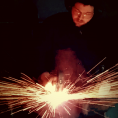-
Posts
733 -
Joined
-
Last visited
Profile Information
-
Location
New York State
-
Interests
Bladesmithing, Archery, Smelting
Recent Profile Visitors
4,594 profile views
-
Older thread, surely, but im curious, Steve. What if you attempted to add carbon via carburization? As in, the same way shear steel and blister steel are made. One assumes that if the meteorite is of high enough iron content, the carbon will migrate into it, yes? I wonder if the high nickel content usually found in meteorites would inhibit carbon uptake? It would likely be better to refine the meteorite first, in order to get it as purely metallic as possible, before carburizing, similarly to how wrought iron would be refined before it was carburized. This is just my speculation.
-

What did you do in the shop today?
Will W. replied to Mark Ling's topic in Blacksmithing, General Discussion
Billy Thats. So. Cool. What an awesome idea. Never occured to me to make a shifter. Another idea added to the list. I think it came out looking good for being "rushed." -
Ax and hammer handles: ash is my go-to. Tough, light, and takes a stain well. Favorite knife handle material? Well jeez, thats a huge question in its own right. Cocobolo, Bocote, Ebony and Desert Ironwood are among my favorites for exotics, and black walnut is my favorite for domestics.
-

Feng shui in a blacksmith shop
Will W. replied to Glenn's topic in Blacksmithing, General Discussion
Hmm... bending a piece back and forth quickly will produce quite a bit of heat... im sure if i open my car door at 60 mph and scrub my workpiece on the asphalt, i could produce some heat... angle grinder? -
I see. Well, i wish i had the skill to produce patterns such as that, i would be glad to help, Steve.
-
Im sure you could google those terms and find a plethora of results under images.
-

Feng shui in a blacksmith shop
Will W. replied to Glenn's topic in Blacksmithing, General Discussion
I rearrange the tools in my shop quite often. I usually put them right in the last spot i would think of when i next need them. Now, please excuse me. Where did i put the 10mm socket...?! -
That makes sense, it would likely also help bring the wrought to the higher temperature needed to weld. Thank you for the tip.
-
I know that it is a common method, or was perhaps, i meant from my experience it would be interesting, having never tried it. May have to give it a try sometime.
-
True enough, i concede your point. Thank you for the information gentleman. I do not plan to make a flintlock (yet) but it is worthwhile information nontheless. Never tried welding high carbon to wrought. I bet that would be interesting! Lol.
-
Hey all. I realize theres a gunsmithing section of this forum, but thats a very low traffic section near the bottom, as such i thought i could receive more information by placing this thread in General HT. Traditionally, the frizzen of a flintlock was case hardened, to provide a sufficient surface for the flint to create sparks from. My question; could you simply through harden a piece of, say, 1095 and do a low temper at 350-400° F? While i am no expert, i imagine frizzens were typically case hardened because it was simply easier, given the materials of the time. When demand for rifles was high, using high carbon blister steel would likely be too time consuming and expensive, and also a waste of good quality steel that could be used elsewhere, such as in the springs or barrels. Nowadays, we have easy access to high carbon steel, so it would seem logical to through harden a piece of that instead of going through the process of case hardening. But could one expect similar results? Thanks.
-
Its in remarkable shape for its age, to be sure. The seam where it appears the face was welded on looks odd to me. How does it sound when hit with a hammer?
- 10 replies
-
- arm & hammer
- age?
-
(and 2 more)
Tagged with:
-

What does a grandfather do when a grandson wants to make a knife
Will W. replied to MotoMike's topic in Knife Making
Really has an effect on the self esteem when a 9 year old makes a better first knife than I did . Seriously though, that is soooo cool. Kids need to learn the value of working with their hands. Good on you for letting him and helping him. Like Frosty said, hes going to be telling HIS grandkids about that knife. -
Steelmaking Before Bessemer is actually on my "need to buy" list, Thomas. Seems like a good set. I believe it was your recommendation (among *many* others) that brought it to my attention, so thank you, i suppose. Crucible steel is very interesting, Steve. I look forward to reading about it.
-
AEB-L creates a very nice edge due to its chemistry being designed for a lack of large carbide formation, assuming a correct heat treat of course. Its a great stainless to work with, IMO. Lots of bladesmiths recommend it for razors.




